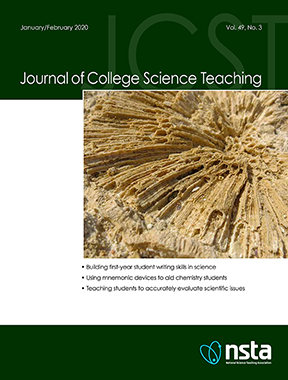
Volume 49, No. 3, January/February 2020

Volume 49, No. 3, January/February 2020

Volume 49, No. 3, January/February 2020
In this lesson, suggested for grades K-2, students learn about bee anatomy and behavior. They develop and test bee models to demonstrate their understanding of the interrelationships between plants and pollinators. After examining some of the controversies around bee decline, they also build a class mason bee hotel and develop educational bee posters to become advocates for the bees. This lesson promises to keep your students very buzzy!. Before beginning the lesson, we recommend reading Units I and IV, which are included in this book selection.
In this lesson, suggested for grades K-2, students learn about bee anatomy and behavior. They develop and test bee models to demonstrate their understanding of the interrelationships between plants and pollinators. After examining some of the controversies around bee decline, they also build a class mason bee hotel and develop educational bee posters to become advocates for the bees. This lesson promises to keep your students very buzzy!. Before beginning the lesson, we recommend reading Units I and IV, which are included in this book selection.
How Can We Provide Water for Developing Countries? 5E Unit Empowers Students to Solve the Global Water Crisis

Students use science knowledge and engineering skills to address a significant real-world problem.
Students use science knowledge and engineering skills to address a significant real-world problem.
Students use science knowledge and engineering skills to address a significant real-world problem.
This chapter provides recommendations for translating standards into instructional materials that are usable for those with the real task of teaching. The discussion provides an affirmative answer to the question: How can the BSCS 5E Instructional Model be used to implement the Next Generation Science Standards (NGSS)? The chapter draws on insights the author gained during his work on both the National Science Education Standards (NRC 1996) and the NGSS (NGSS Lead States 2013).
This chapter provides recommendations for translating standards into instructional materials that are usable for those with the real task of teaching. The discussion provides an affirmative answer to the question: How can the BSCS 5E Instructional Model be used to implement the Next Generation Science Standards (NGSS)? The chapter draws on insights the author gained during his work on both the National Science Education Standards (NRC 1996) and the NGSS (NGSS Lead States 2013).
Press Release
Exceptional Young Scientists Awarded Scholarships and Awards at the 63rd Annual National Junior Science and Humanities Symposium
Over $200,000 in scholarships and cash awards were awarded to national winners at this year’s National Junior Science and Humanities Symposium
Science Update: The Dynamic Atmosphere: Extreme Weather, June 26, 2025
Join us on Thursday, June 26, 2025, from 7:00 PM to 8:00 PM ET, to learn about the science behind extreme weather.
Join us on Thursday, June 26, 2025, from 7:00 PM to 8:00 PM ET, to learn about the science behind extreme weather.
Join us on Thursday, June 26, 2025, from 7:00 PM to 8:00 PM ET, to learn about the science behind extreme weather.
Join us on Thursday, June 26, 2025, from 7:00 PM to 8:00 PM ET, to learn about the science behind extreme weather.
Time Travelers
Biological, Sociological, and Psychological Adventures in Vaccination
By Thanos Myloneros, Ilaria Montagni, Janet A. De Souza-Hart

Freebies and Opportunities for Science and STEM Teachers, April 29, 2025
By Debra Shapiro

Date Night Gone Wrong
An Unusual Case of Alcoholic Fermentation
By Cocoa T. Dixon


